 W
WThe ʻakekeʻe is a bird species in the family Fringillidae, where it is placed in the Hawaiian honeycreeper genus Loxops. It is endemic to the island of Kauaʻi where it is found in small numbers in higher elevations. Because of their similar size, shape, and unusual bill, the ʻakekeʻe and the ʻakepa were for some time classified as a single species. This was eventually changed, because of differences in their color, nesting behavior, and calls.
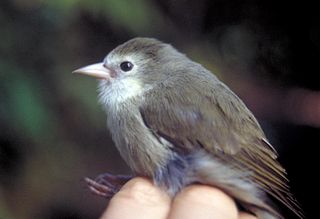 W
WThe ʻakikiki, also called the Kauaʻi creeper, is a critically endangered Hawaiian honeycreeper endemic to Kauaʻi, Hawaiʻi.
 W
WThe ʻākohekohe, or crested honeycreeper, is a species of Hawaiian honeycreeper. It is endemic to the island of Maui in Hawaiʻi.
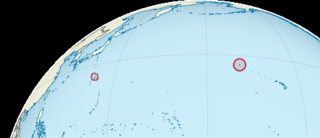 W
WBryan's shearwater is a species of shearwater that may occur around the Hawaiian Islands. It is the smallest species of shearwater and is black and white with a bluish gray beak and blue tarsi. First collected in 1963 and thought to be a little shearwater it was determined using DNA analysis to be distinct in 2011. It is rare and possibly threatened and there is little information on its breeding or non-breeding ranges. The species is named after Edwin Horace Bryan Jr. a former curator of the B. P. Bishop Museum at Honolulu.
 W
WThe Kauaʻi nukupuʻu is a species of nukupuʻu once found throughout parts of the Hawaiian island of Kauaʻi. It is an insect eater that picks out its tiny prey from tree bark. The males are yellowish with brown wings, while the females are grayish brown with a yellow throat streak.
 W
WThe Laysan duck, also known as the Laysan teal, is a dabbling duck endemic to the Hawaiian Islands. Fossil evidence reveals that Laysan ducks once lived across the entire archipelago, but today survive only on Laysan Island and two atolls. The duck has several physical and behavioral traits linked to the absence of ground-based predators in its habitat. By 1860, the ducks had disappeared from everywhere except Laysan Island. The introduction of rabbits brought the bird to the brink of extinction in 1912 with twelve surviving individuals. Rabbits were eradicated from the island in 1923 and numbers of Laysan ducks began to rise, reaching 500 by the 1950s. In an effort to ensure the long-term future of this duck, 42 birds were translocated to Midway Atoll National Wildlife Refuge in 2002. These thrived in their new surroundings, and another group were later relocated to Kure Atoll.
 W
WThe ʻakekeʻe is a bird species in the family Fringillidae, where it is placed in the Hawaiian honeycreeper genus Loxops. It is endemic to the island of Kauaʻi where it is found in small numbers in higher elevations. Because of their similar size, shape, and unusual bill, the ʻakekeʻe and the ʻakepa were for some time classified as a single species. This was eventually changed, because of differences in their color, nesting behavior, and calls.
 W
WThe Maui nukupuʻu is a species of nukupu‘u Hawaiian honeycreeper that is endemic to the island of Maui in the Hawaiian Islands. The small, five-inch-long bird lives only in eastern Maui, where it is dependent on high-elevation mesic and wet forests of ʻōhiʻa lehua and koa. These two species of trees attract insects, causing the Maui nukupuʻu to have a higher chance of finding a meal near these trees.
 W
WThe Maui parrotbill or kiwikiu is a species of Hawaiian honeycreeper, that is endemic to Maui in Hawaii. It can only be found in 50 square kilometres (19 sq mi) of mesic and wet forests at 1,200–2,150 metres (3,940–7,050 ft) on the windward slopes of Haleakalā. This species is critically endangered, with an estimated population of only 500 individuals. Fossil evidence indicates that the bird could at one time be seen in dry forests at elevations as low as 200–300 metres (660–980 ft), as well as on the island of Molokaʻi.
 W
WMegalagrion leptodemas is a species of damselfly in the family Coenagrionidae that is endemic to the island of Oʻahu in Hawaii. It inhabits rivers in the Waiʻanae and Koʻolau ranges. It is threatened by habitat loss. It is currently labeled as critically endangered.
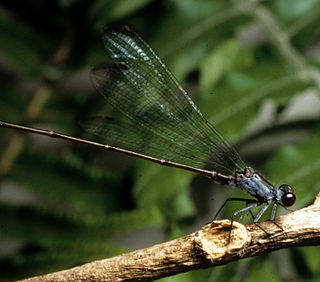 W
WMegalagrion nesiotes is a species of damselfly in the family Coenagrionidae. Its common name is flying earwig Hawaiian damselfly. It is endemic to Hawaiʻi, where it is known from only one location on the island of Maui. It is extirpated from the island of Hawaii. This insect was federally listed as an endangered species of the United States in 2010.
 W
WMegalagrion nigrohamatum is a species of damselfly in the family Coenagrionidae that is endemic to Hawaii.
 W
WThe poʻo-uli, or black-faced honeycreeper, is an extinct species of passerine bird that was endemic to the island of Maui in Hawaiʻi. It is considered to be a member of the Hawaiian honeycreepers, and is the only member of its genus Melamprosops. It has a black head, brown upper parts and pale grey underparts. This bird inhabits only the drier, easternmost side of Maui, where it has rapidly decreased in numbers. With extinction threatening, efforts were made to capture birds to enable them to breed in captivity. This has been largely unsuccessful; in 2004, only two known birds remained, and since then, no further birds have been sighted. A 2018 study recommended declaring the species extinct, citing bird population decline patterns and the lack of any confirmed sightings since 2004, and in 2019, the species was declared extinct.
 W
WThe millerbird is a species of Old World warbler in the family Acrocephalidae. It has two subspecies, A. f. kingi and A f. familiaris. The latter, the Laysan millerbird, became extinct sometime between 1916 and 1923. The former, the critically endangered Nihoa millerbird, remains the only race left, inhabiting the small island Nihoa in Hawaiʻi, though it has since been reintroduced to Laysan. It is the only Old World warbler to have colonised Hawaiʻi, although there is no fossil evidence that the species ever had a distribution beyond these two islands.
 W
WThe olomaʻo is a small, dark solitaire endemic to Maui, Lānaʻi and Molokaʻi in the Hawaiian Islands. It is probably extinct. It grows up to 7 inches in length. The male and female of the species look similar. It is dark brown above and gray below with blackish legs. It is closely related to the other species of Hawaiian thrushes, the puaiohi, ʻōmaʻo, and the probably extinct kāmaʻo.
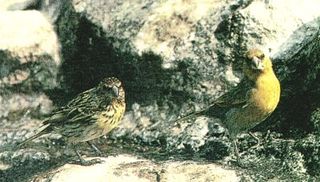 W
WThe Nihoa finch is one of the two endemic bird species of the tiny Hawaiian island Nihoa, the other being the Nihoa millerbird. When it was classified in 1917, scientists thought that it would be the last endemic species named. This was later found untrue. The island's population is 1000–3000 birds. The Nihoa finch was added to the Endangered Species List by the U.S. Fish and Wildlife Service on March 11, 1967. An attempt to protect the species against extinction was made by starting a colony on French Frigate Shoals, another leeward island. This would ensure its continued existence in the event that the Nihoa population was wiped out. This attempt, however, failed. Nihoa is part of a group of islands that make up the Hawaiian Islands National Wildlife Refuge which provides protected land for the Nihoa finch to roam on.
 W
WThe Nihoa millerbird is a subspecies of the millerbird. It gets its name from its preferred food, the Miller moth. The 5-inch (13 cm) long millerbird has dark, sepia-colored feathers, white belly, and dark beak. Its natural geographic range is limited to the tiny island of Nihoa in the Northwestern Hawaiian Islands, and it is hoped that birds translocated to Laysan will help to ensure the survival of the species. The Nihoa millerbird is one of the two endemic birds remaining on Nihoa, the other being the Nihoa finch.
 W
WThe nukupuʻu is a group of critically endangered species of Hawaiian honeycreeper in the family Fringillidae. There are no recent confirmed records for any of the species and they may be extinct or functionally extinct. Habitat was dense mesic and wet forest of ʻōhiʻa lehua and koa at altitudes of 3,300–6,600 feet (1,000–2,000 m).
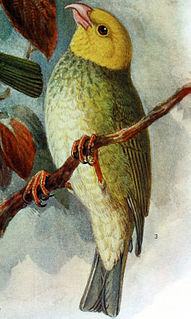 W
WThe ʻōʻū, is a species of Hawaiian honeycreeper, that is endemic to the Hawaiian islands. It has a dark green back and olive green underparts; males have a yellow head while females have a green head. Its unusual beak seems to be adapted to feeding on the fruits of Freycinetia arborea. It has a strong flight which it uses to fly considerable distances in search of this Hawaiian endemic vine, but will eat other fruits, buds, flowers and insects.
 W
WThe O'ahu 'alauahio, also known as the Oahu creeper, is a small finch-like Hawaiian honeycreeper that is endemic to the Hawaiian island of Oahu.
 W
WThe olomaʻo is a small, dark solitaire endemic to Maui, Lānaʻi and Molokaʻi in the Hawaiian Islands. It is probably extinct. It grows up to 7 inches in length. The male and female of the species look similar. It is dark brown above and gray below with blackish legs. It is closely related to the other species of Hawaiian thrushes, the puaiohi, ʻōmaʻo, and the probably extinct kāmaʻo.
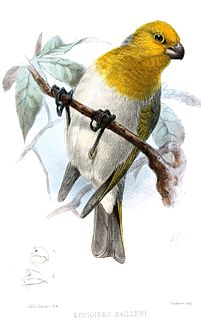 W
WThe palila is a critically endangered finch-billed species of Hawaiian honeycreeper. It has a golden-yellow head and breast, with a light belly, gray back, and greenish wings and tail. The bird has a close ecological relationship with the māmane tree, and became endangered due to destruction of the trees and accompanying dry forests. The first specimen of the palila was collected in 1876 at the Greenwell Ranch on the Big Island by Pierre Étienne Théodore Ballieu (1828–1885), who was French consul in Hawai‘i from 1869 to 1878. The type specimen is housed at the Muséum national d'histoire naturelle in Paris.
 W
WThe O'ahu 'alauahio, also known as the Oahu creeper, is a small finch-like Hawaiian honeycreeper that is endemic to the Hawaiian island of Oahu.
 W
WThe Maui parrotbill or kiwikiu is a species of Hawaiian honeycreeper, that is endemic to Maui in Hawaii. It can only be found in 50 square kilometres (19 sq mi) of mesic and wet forests at 1,200–2,150 metres (3,940–7,050 ft) on the windward slopes of Haleakalā. This species is critically endangered, with an estimated population of only 500 individuals. Fossil evidence indicates that the bird could at one time be seen in dry forests at elevations as low as 200–300 metres (660–980 ft), as well as on the island of Molokaʻi.
 W
WThe ʻōʻū, is a species of Hawaiian honeycreeper, that is endemic to the Hawaiian islands. It has a dark green back and olive green underparts; males have a yellow head while females have a green head. Its unusual beak seems to be adapted to feeding on the fruits of Freycinetia arborea. It has a strong flight which it uses to fly considerable distances in search of this Hawaiian endemic vine, but will eat other fruits, buds, flowers and insects.
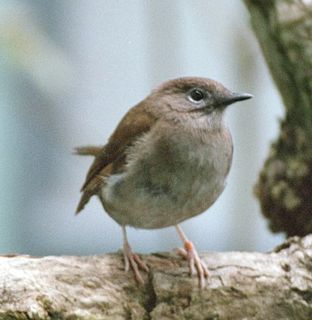 W
WThe puaiohi, or small Kauaʻi thrush, is a rare species of songbird in the thrush family, Turdidae, that is endemic to the Hawaiian island of Kauaʻi. It is closely related to the other four endemic Hawaiian thrushes, the kāmaʻo, olomaʻo, ʻōmaʻo, and ʻāmaui. It was first collected by Henry Palmer in 1891 at Halemanu around the entrance to the Kōkeʻe State Park.
 W
WThe Nihoa finch is one of the two endemic bird species of the tiny Hawaiian island Nihoa, the other being the Nihoa millerbird. When it was classified in 1917, scientists thought that it would be the last endemic species named. This was later found untrue. The island's population is 1000–3000 birds. The Nihoa finch was added to the Endangered Species List by the U.S. Fish and Wildlife Service on March 11, 1967. An attempt to protect the species against extinction was made by starting a colony on French Frigate Shoals, another leeward island. This would ensure its continued existence in the event that the Nihoa population was wiped out. This attempt, however, failed. Nihoa is part of a group of islands that make up the Hawaiian Islands National Wildlife Refuge which provides protected land for the Nihoa finch to roam on.